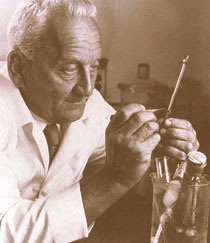 Albert von Szent-Györgyi was born in Budapest September 16, 1893, son of Nicolas von Szent-Györgyi, a large landowner and Josephine, whose father, Joseph Lenhossék, and his brother Michael were both professors of anatomy at the University of Budapest. He enrolled in 1911 and entered his uncle's laboratory where he studied until the outbreak of World War I, when he was drafted. He served in the Italian and Russian fronts, won the silver medal for heroism, and he was released in 1917 after being wounded in action. He completed his studies in Budapest and then worked successively with the pharmacist, G. Mansfeld at Pozsony with Armin von Tschermak in Prague, where he studied electrophysiology, and Michael L. in Berlin before going to Hamburg for a two-year course in physical chemistry at the Institute of Tropical Hygiene.
Albert von Szent-Györgyi was born in Budapest September 16, 1893, son of Nicolas von Szent-Györgyi, a large landowner and Josephine, whose father, Joseph Lenhossék, and his brother Michael were both professors of anatomy at the University of Budapest. He enrolled in 1911 and entered his uncle's laboratory where he studied until the outbreak of World War I, when he was drafted. He served in the Italian and Russian fronts, won the silver medal for heroism, and he was released in 1917 after being wounded in action. He completed his studies in Budapest and then worked successively with the pharmacist, G. Mansfeld at Pozsony with Armin von Tschermak in Prague, where he studied electrophysiology, and Michael L. in Berlin before going to Hamburg for a two-year course in physical chemistry at the Institute of Tropical Hygiene.In 1920 he became assistant at the Graduate Institute of Pharmocology in Leiden, and from 1922 to 1926 he worked with HJ Hamburger, Department of Physiology, Groningen, Netherlands. In 1927 he went to Cambridge as a Rockefeller Fellow, working under FG Hopkins, and spent a year at the Mayo Foundation, Rochester, Minnesota, before returning to Cambridge. In 1930, he was President of Medical Chemistry, University of Szeged and in 1935 he also assumed the presidency in organic chemistry. At the end of World War II, he took the Chair for Medicinal Chemistry in Budapest and in 1947 he left Hungary to settle in the United States where he is Director of Research, Institute for Muscle Research, Woods Hole, Massachusetts.

Szent-Gyorgyi in Groningen in the early studies concerned the chemical breathing. He described the interdependence of oxygen and hydrogen activation, and made his first observations dehydrases partnerships and systems of plant polyphenol oxidase. He also showed the existence of a material to reduce plant and animal tissue. Cambridge and during his early stay in the United States, has further isolated from the kidneys to reduce this substance, which is now known as ascorbic acid. Returning to Cambridge in 1929, then described the pharmacological activity of nucleotides with Drury.
When he returned to Hungary, he noted the anti-scorbutic ascorbic acid and found that the paprika (Capsicum annuum) has been a rich source of vitamin C. His continuing studies on the biological oxidation led to the recognition of the catalytic function of C4-dicarboxylic the discovery of "cytoflav" (flavin) and a recognition of the biological activity and the likely nature of vitamin flavanone (vitamin P).
In 1938 he began work on muscle research and soon discovered the proteins actin and myosin and their complexes. This led to a reproduction of muscle contraction reaction base, which formed the basis for research of muscle in the following decades. The preservation of biological material in the glycerine, which was an application scope, including agriculture in the conservation of semen is the result of his later work. He also developed the use of rabbit psoas muscle as an experimental material that was published theories on the problems of energy and studied the regulation of growth and cell membrane potential, and hormonal function of the thymus.
Szent-Györgyi, a member of the scientific community a lot, is a former president of the Academy of Sciences, Budapest, and vice-president of the National Academy in Budapest. He was a visiting professor at Harvard University in 1936 and Franchi professor at the University of Liege, 1938. He received the Cameron Prize (Edinburgh) in 1946 and the Lasker Award in 1954. His many publications include oxidation, fermentation, vitamins, health and disease (1939), muscle twitching (1947), The Nature of Life (1947) Contraction of the muscles of the body and heart (1953) and bioenergetics (1957) .
Szent-Gyorgyi Demeny married Cornelia, the daughter of the Hungarian Postmaster General, 1917. In 1930 he was active in the anti-Nazi during the Second World War, became a Swedish citizen - who has received extensive assistance to the Swedish Embassy in Budapest. In 1941 he married Martha Borbiro, a colleague at the Woods Hole have a daughter.
He is interested in sports of all kinds, his favorites are sailing and mountaineering.
Lessons from Nobel in Physiology or Medicine 1922-1941, Elsevier Publishing Company, Amsterdam, 1965
This autobiography / biography was written at the time of the award and first published in the book series Les Prix Nobel. Which was published and then republished in Nobel Conferences. To cite this document indicate the source as shown above.










0 comments:
Post a Comment